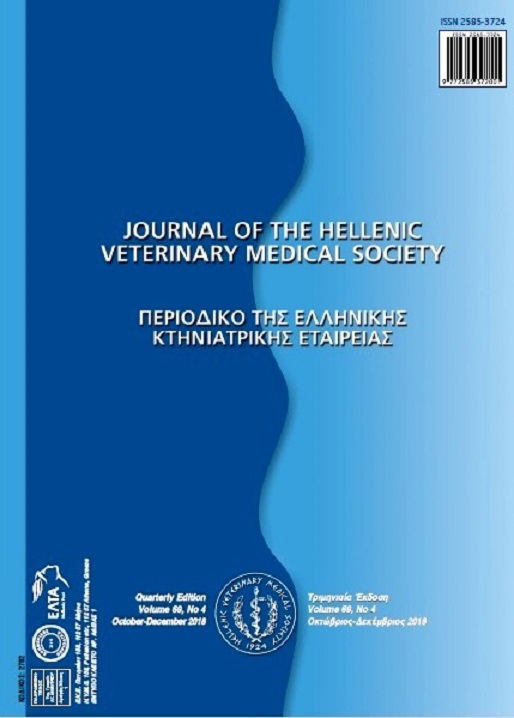Ovarian remnant syndrome after laparoscopic ovariectomy in a cat
Περίληψη
The first case of accidental implantation of ovarian tissue at the port site after laparoscopic ovariectomy in a cat was described. A 2-year-old, spayed female, domestic cat showed recurrent behavioral oestrus signs (vocalization, increased playfulness, and lordosis) four months after laparoscopic ovariectomy. Abdominal ultrasound revealed bilateral endometrial hyperplasia and an inhomogeneous mass attached to the abdominal wall at the port site of previous laparoscopic ovariectomy. Ovarian remnant syndrome was supposed. Diagnostic laparoscopy confirmed the presence of a mass that was 2 cm in diameter and macroscopically similar to ovarian tissue. Laparoscopy was converted to laparotomy to remove the abnormal tissue and the uterus. Histopathological findings showed follicles of various maturation stages in the mass, and confirmed endometrial hyperplasia. Histology underscored that ovarian remnant tissue resumed function. No clinical signs consistent with ovarian remnant syndrome were reported six months after removal of the abnormal tissue. In conclusion, removal of the ovaries through the laparoscopic port site may cause fortuitous ovarian tissue implantation at the abdominal wall in the cat.
Λεπτομέρειες άρθρου
- Πώς να δημιουργήσετε Αναφορές
-
Properzi, R., Boschi, P., & Leonardi, F. (2019). Ovarian remnant syndrome after laparoscopic ovariectomy in a cat. Περιοδικό της Ελληνικής Κτηνιατρικής Εταιρείας, 69(4), 1305–1308. https://doi.org/10.12681/jhvms.15906
- Τεύχος
- Τόμ. 69 Αρ. 4 (2018)
- Ενότητα
- Case Report

Αυτή η εργασία είναι αδειοδοτημένη υπό το CC Αναφορά Δημιουργού – Μη Εμπορική Χρήση 4.0.
Οι συγγραφείς των άρθρων που δημοσιεύονται στο περιοδικό διατηρούν τα δικαιώματα πνευματικής ιδιοκτησίας επί των άρθρων τους, δίνοντας στο περιοδικό το δικαίωμα της πρώτης δημοσίευσης.
Άρθρα που δημοσιεύονται στο περιοδικό διατίθενται με άδεια Creative Commons 4.0 Non Commercial και σύμφωνα με την άδεια μπορούν να χρησιμοποιούνται ελεύθερα, με αναφορά στο/στη συγγραφέα και στην πρώτη δημοσίευση για μη κερδοσκοπικούς σκοπούς.
Οι συγγραφείς μπορούν να καταθέσουν το άρθρο σε ιδρυματικό ή άλλο αποθετήριο ή/και να το δημοσιεύσουν σε άλλη έκδοση, με υποχρεωτική την αναφορά πρώτης δημοσίευσης στο J Hellenic Vet Med Soc
Οι συγγραφείς ενθαρρύνονται να καταθέσουν σε αποθετήριο ή να δημοσιεύσουν την εργασία τους στο διαδίκτυο πριν ή κατά τη διαδικασία υποβολής και αξιολόγησής της.



